
Heterocrossa eriphylla is a species of moth in the family Carposinidae. It is endemic to New Zealand and is found in the North Island and the northern parts of the South Island. This species is regarded as relatively uncommon and inhabits native forest. The larvae feed on the healing wounds of New Zealand beech trees Fuscospora fusca and Fuscospora truncata. It pupates at its feeding site and emerges from December onward. The adult moth is nocturnal and is attracted to light. During the day the moth rests on lichen covered tree trunks where their lichen mimicking colouration assists with their camouflage.

Heterocrossa exochana is a species of moth in the family Carposinidae. It is endemic to New Zealand and has been observed in the North and South Islands. The larvae of this species feed on the fruits of Muehlenbeckia species. The adult is on the wing from September until May and are attracted to light.

Pasiphila plinthina is a moth in the family Geometridae. It is endemic to New Zealand and is found in both the North, South and Stewart Islands. It is on the wing mainly from June until September with occasional observations up to December, and is attracted to light. This species is similar in appearance to P. sandycias but can be distinguished from it as P. plinthina has palpi that are longer and has more blurred forewing markings.
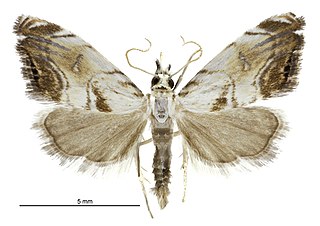
Glaucocharis harmonica is a moth in the family Crambidae. This species was described by Edward Meyrick in 1888. It is endemic to New Zealand and is found in the North and South Islands. It inhabits lowland to subalpine native forest. It has been hypothesised that there are two broods per year. The larval hosts are unknown. Adults are on the wing from October until January.

Pyrgotis eudorana is a species of moth of the family Tortricidae. It is endemic in New Zealand and has been observed in both the North and South Islands. However it is regarded as a rare insect. This species inhabits native forest. Larvae exclusively feed on Muehlenbeckia australis and adults are on the wing from November to April. Adults are attracted to light.

Pyrgotis transfixa is a species of moth of the family Tortricidae. It is endemic to New Zealand. It is classified as "At Risk, Naturally Uncommon" by the Department of Conservation.
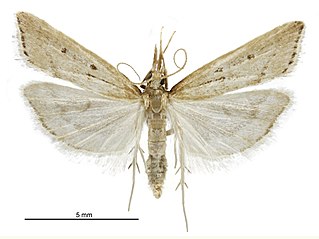
Antiscopa elaphra is a moth in the family Crambidae. It is endemic to New Zealand and has been observed in both the North and South Islands. Adults of this species are on the wing from August until March and are attracted to light. In 2020 this species had its DNA barcode sequenced.

Asaphodes albalineata is a species of moth in the family Geometridae. It is endemic to New Zealand and has been observed on Stewart Island / Rakiura. This species is similar in appearance to Asaphodes oraria but can be distinguished as it has an unusual pattern on the underside of its hindwings. It inhabits open hill tops and adults are on the wing in December.

Asaphodes chlorocapna is a species of moth in the family Geometridae. This species is endemic to New Zealand and can only be found in the Chatham Islands. The larvae of this species consume the leaves of Muehlenbeckia plants. Adults are on the wing in January. This species is classified as "At Risk, Relict'" by the Department of Conservation.

Asaphodes cosmodora is a species of moth in the family Geometridae. This species is endemic to New Zealand and has been observed in the South Island. The adults of this species are on the wing in January and February.

Asaphodes dionysias is a species of moth in the family Geometridae. This species is endemic to New Zealand and is only known from mountainous areas in Central Otago. It lives in open grassy mountainous habitat at altitudes up to 1750 m. It is also known to live in wetland habitat. The larvae of this species feed on native herbs. The adults of this species are on the wing in January and February. The adult female of the species has reduced wing size in comparison to the male.
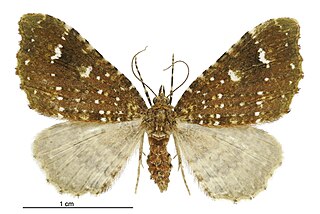
Asaphodes limonodes is a species of moth in the family Geometridae. It is endemic to New Zealand and is found in both the North and South Islands. This species inhabits damp native forest. Adults are on the wing from November until March.
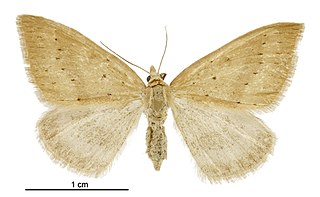
Asaphodes mnesichola is a species of moth in the family Geometridae. It is endemic to New Zealand and has been observed in the South Island. This species inhabits subalpine native scrub. Adults of this species are on the wing in January and February.

Tingena hemimochla is a species of moth in the family Oecophoridae. It is endemic to New Zealand and has been observed in the North Island. Adults of this species are on the wing from December until March.

Asaphodes nephelias is a moth in the family Geometridae. It is endemic to New Zealand and has been observed in the South Island. The preferred habitat of this species is alpine tussock grasslands above native forest and in wetlands. The adults of this species are on the wing from January to March and are day flying. The female has brachypterous wings.

Asaphodes prymnaea is a moth in the family Geometridae. It is endemic to New Zealand and can be found on the Mount Arthur tableland. It is common in limestone valleys. The female of the species is paler and has less distinctive markings than the male. Adults are on the wing in January and February.

Asaphodes sericodes is a moth in the family Geometridae. It is endemic to New Zealand and has been observed in the southern parts of the South Island. This species inhabits open tussock grasslands in subalpine scrub or wetlands. The female of the species is likely semi-apterous and is flightless. The adult males are on the wing in January.
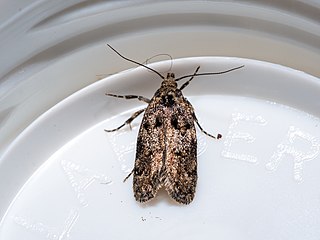
Trachypepla anastrella is a species of moth in the family Oecophoridae. It is endemic to New Zealand and has been observed in the North and South Islands. Larvae are leaf litter feeders from the host plant Olearia fragrantissima and adults are on the wing from December until March.
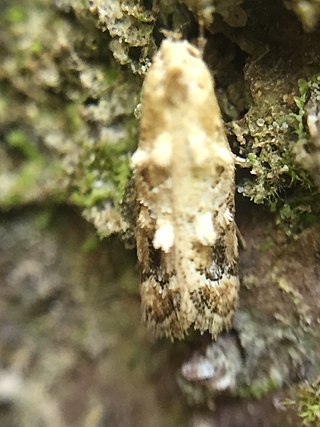
Trachypepla aspidephora is a species of moth in the family Oecophoridae. It is endemic to New Zealand and has been observed in the North and South Islands. Adults are on the wing from November to March and are attracted to light. The moths can be found resting on tree trunks where their colouration imitates lichens.

Atomotricha chloronota is a moth in the family Oecophoridae first described by Edward Meyrick in 1914. It is endemic to New Zealand and is found in the eastern side of the South Island and at the Antipodes Islands. It inhabits clearings with native tussocks and ferns. The larvae feed on leaf litter from silk tunnels in soil. The male adults of this species are on the wing from July to September and have been trapped via sugar traps and are attracted to light. The female of this species is brachypterous.























